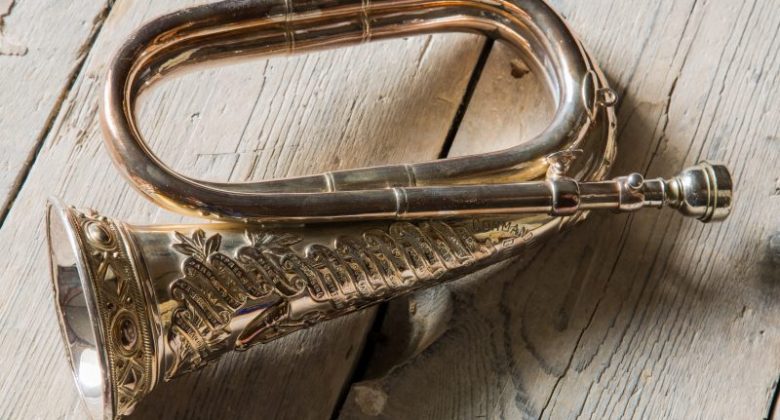Our Object of the Month for September is the beautiful Commanding Officer’s Bugle.
The sound of the bugle is synonymous with the military. Many will recognise the ‘Last Post’ – the bugle call played at military funerals and ceremonies that commemorate those killed in war – but the sound of the bugle once formed part of day to day military life as well.
First introduced to the British Army in the 1760s, the bugle was used both in the field of battle and to inform soldier and officer alike of the time of day, keeping life in the barracks running like clockwork. The bugle became an important symbol of the Light Infantry regiments, who favoured it over the traditional military drum due to its advantages on the battlefield. Where drums are heavy and unwieldy, the bugle can be easily carried, and the call of a bugle travels further than the sound of a drumbeat. For these reasons the bugle became the main symbol of light companies, featuring heavily in the insignia of Light Infantry regiments throughout history – including the Duke of Cornwall’s Light Infantry, to which this bugle belongs.
The Commanding Officer’s Bugle is one of many musical instruments that can be found in Cornwall’s Regimental Museum, however this ornate example has a special significance. This very special bugle is decorated intricately with scrolls depicting the Battle Honours of the Duke of Cornwall’s Light Infantry regiment.

At one time the bugle belonged to Joe Kendall, the former museum attendant at Cornwall’s Regimental Museum, who had been a Commanding Officer’s Bugler while serving in the military. Sadly, Joe passed away in 2008, but has the unique honour of playing the bugle at his own funeral – a recording he made of himself sounding the ‘Last Post’ was played during the ceremony.
The simple brass bugle was developed from early animal horn instruments, and unlike a trumpet, it has no valves to produce different notes – that is entirely down to the talent and technique of the bugle player. If you’d like to put your own skills to the test, you can visit the Regimental Museum and try playing a bugle for yourself. There is also the chance to try out the Museum’s Fun Trail and Quiz and try and count the number of musical instruments on display – from bugles to banjos!
See our Object of the Month for August 2017 here: The 1914 Recruitment Leaflet
If you’d like to keep up to date with our news, and see more articles like this one, please join our free e-newsletter mailing list at the bottom of this page, or get in touch!

